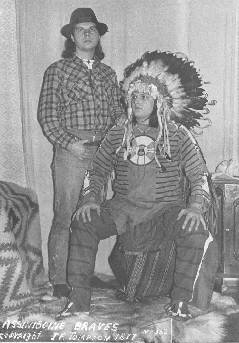 Another Stereotype of the Month entry:
Another Stereotype of the Month entry:
 Another Stereotype of the Month entry:
Another Stereotype of the Month entry:
Posted on Tue, Apr. 06, 2004
DORREEN YELLOW BIRD COLUMN: Germany's 'hobby Indians' pass for real — almost
Birgit Hans, department chair of Indian Studies at UND, had a unique presentation Wednesday for the UND Indian Association's 35th Annual Time-Out and Wacipi Week. She told us about the "hobby Indians" in Germany. Hans talked from experience and with expertise. She is, after all, German and is researching the subject for a book.
"Gee whiz," I thought after I saw her presentation. "These people may be better at being Indian than we are -- at least in regalia"
The German interest in American Indian culture isn't new. It dates back centuries, Hans said. These "hobbyists" have created a new kind of Indian based on some early prolific writers, who wrote grand, Old West-type stories about the escapades of American Indians though the writers never visited this country.
Her slide collection was telling. One of the slides showed a sea of white conical teepees. That was the weekend village for the hobbyists, she explained.
She went into the villages. The hobbyists follow the dress and culture of Indian people down to the kind of beads and buckskin used in the Indians' outfits in the early 1800s. In fact, Hans said, the hobbyists will challenge each other if design, feather or bead is not authentic, based on their readings.
The hobbyists are excellent craftsmen. They come in full dress when attending ceremonies such as marriage or naming. One of the hobbyists, she said, took Hans to his home, where he lived with his wife. Every wall was covered with buckskin dresses and outfits for men, dance outfits for both men and women, moccasins, pipe or tobacco bags, belts, knife cases and every kind of miscellaneous item you can think of that is or has been used by Indians.
The woman of this house showed six dresses that she had made. These dresses were fully beaded. Native people who bead know that is a daunting task.
The house was sensory overload, Hans said. This hobby is considered good for keeping families together, she was told.
Hans was not invited to some of the hobbyists' ceremonies. They don't like a lot of publicity either, Hans said.
From Hans' description, there are many pseudo-Indian tribes in Germany. They pick a tribe, study it and try to copy it down to the last bead color. She said she met a man who copied the Arikara (Sahnish), which is my tribe. "Yikes," I thought. "His beadwork might be better than ours."
The hobbyists do not copy modern Indians, Hans said. They don't consider actual members of modern tribes to be Indians. In fact, they consider themselves the real Indians! I was speechless at that comment.
As I sat there looking at Hans' slides of the German hobbyists, I thought of the Germans who had come each year to the South Dakota Sundance ceremony I attend. A group of about 20 to 25 used to fly to the United States each year to attend ceremonies.
They had a camp set up at the South Dakota site, just like the rest of us. In our Sundance, each day for each meal of the day, campers feed the camp. The Germans fed, too, and tried to keep with the traditions.
One evening before the ceremony, the Germans invited everyone to share a late meal. I sat on a tree stump beside a young woman who looked like she might have stepped out of an executive office. I asked her why the Germans came to these ceremonies. Some in Germany had a culture like this more than 200 years ago, the woman told me. They were trying to get in touch with their ancient culture again. Hans was skeptical about her comment.
One of the German men Sundanced. I never heard him speak a word during the four years he danced.
A few years ago, I noticed that the Germans weren't there any more and asked what happened to them. One of the people at the ceremony said the Germans had invited some of the leaders of the ceremony to Germany. The leaders were extremely disappointed when they found the Germans doing their own Sundance, based on what they had learned in South Dakota.
One of the things about these hobbyists, Hans said, is that they have all the regalia and know the ceremonies, but don't seem to have it in here -- and she motioned to her heart.
"Hobby Indians," I thought. "What a turnabout!" They want to replicate who we were but not who we are. The early American settlers called us savages and uncivilized, and these Germans liked our culture from those days. We are more or less accepted by white America today, but Germany's hobby Indians think we're no longer Indian.
There must be a lesson to be learned from the hobby Indians' revelation -- and it might be a good one, if I didn't feel like laughing at the irony of it all.
Rob's comment
Back in 2000 and 2001 I debated at length with some Russian "hobbyists" similar to these German "hobbyists." At least one Russian claimed her people were the keepers of the true Indian faith. The arguments I used there apply here also. (The picture above is of the Russian "Orthodox Wannabe League.")
Related links
Indian wannabes and imitators
|
. . . |

|
All material © copyright its original owners, except where noted.
Original text and pictures © copyright 2007 by Robert Schmidt.
Copyrighted material is posted under the Fair Use provision of the Copyright Act,
which allows copying for nonprofit educational uses including criticism and commentary.
Comments sent to the publisher become the property of Blue Corn Comics
and may be used in other postings without permission.